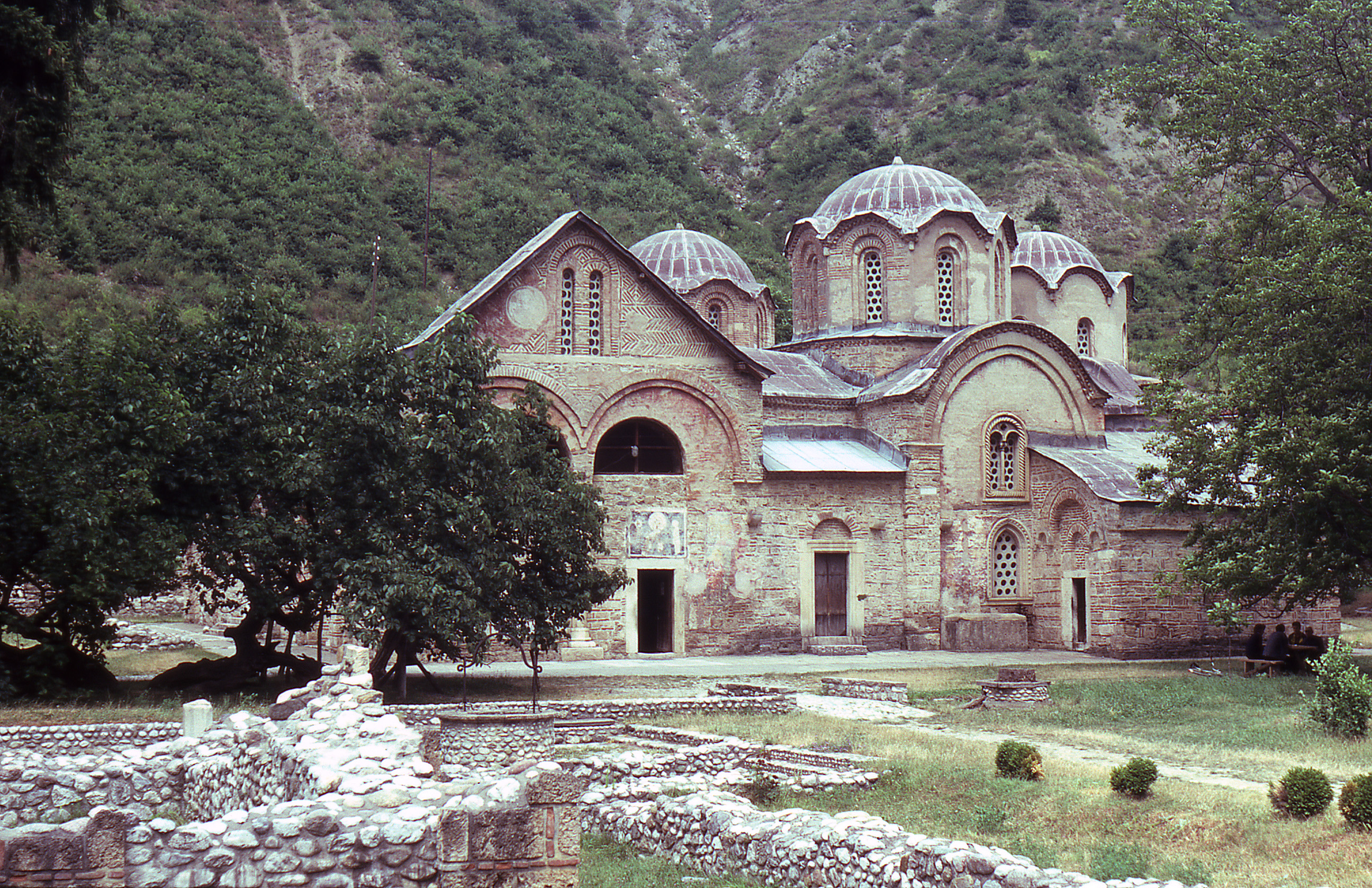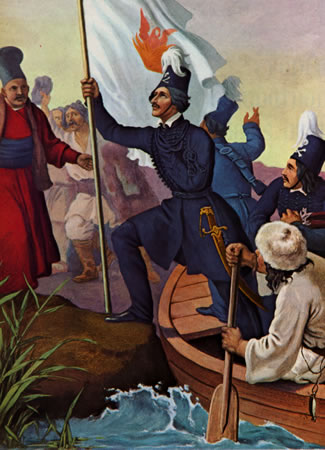|
Savatije Ljubibratić
Savatije Ljubibratić ( sr-cyr, Саватије Љубибратић; Piva, c. 1660—Topla, January, 1716) was a Serbian Orthodox bishop and metropolitan, and the caretaker of the Dragović monastery. Early life Ljubibratić was born in Piva, Montenegro, Piva, and belonged to the Ruđić brotherhood, at a time when the region was part of the Ottoman Empire. Ljubibratić, as many of his relatives, took monastic vows and later became a bishop. Bishop of Herzegovina Since 1687, he was a notable participant in the struggle Ottoman–Venetian Wars, against the Ottomans, in Venetian support. On 10 December 1687, he was present at Tvrdoš when the priest and vojvoda Vukašin Gavrilović with his people came from Nikšić. In 1690, he and the Tvrdoš brotherhood (including his brother Stevan Ljubibratić, Stevan) left Trebinje for Herceg Novi, fleeing the Ottomans, where they renovated the Savina Monastery, Montenegro, Savina Monastery. The Republic of Venice recognized Savatije's ep ... [...More Info...] [...Related Items...] OR: [Wikipedia] [Google] [Baidu] |
Metropolitanate Of Zahumlje
The Eparchy of Zahumlje, Herzegovina and the Littoral () is an eparchy (diocese) of the Serbian Orthodox Church with its seat in Mostar, Bosnia and Herzegovina. It has jurisdiction over the region of Herzegovina, the littoral region of southern Dalmatia in Croatia and a small part of Montenegro. Since 2018, the bishop of Zahumlje and Herzegovina has been Dimitrije Rađenović. History Ecclesiastical background The region was under the Eastern Orthodox Doclea (Illyria), Metropolitanate of Dyrrachium, which in turn was under the Ecumenical Patriarchate of Constantinople or the Roman Catholic Archdiocese of Bar, Archbishopric of Bar. In 1089, the see of Trebinje (''Travunia'') was briefly theoretically under the jurisdiction of the Roman Catholic Archdiocese of Bar, Archbishopric of Bar. The territory was constantly in a feudal state of continuous religious wars between the Roman Catholic and Eastern Orthodox denominations long before the incursion of Islamic invaders. Middle Ages ... [...More Info...] [...Related Items...] OR: [Wikipedia] [Google] [Baidu] |
Ljubibratić
Ljubibratić ( sr-cyr, Љубибратић) is a Serbo-Croatian surname, a patronymic derived from the masculine given name '' Ljubibrat''. The family, or rather, brotherhood, descend from the Ljubibratić noble family active in the Trebinje and Konavle region between 1404 and 1432. It may refer to: *Mićo Ljubibratić (1839–1889), Herzegovinian rebel *Jeronim Ljubibratić (1716–1779), Habsburg military commander * Stefan Ljubibratić (fl. 1687–1718), Metropolitan of Zahumlje and Dalmatia *Savatije Ljubibratić Savatije Ljubibratić ( sr-cyr, Саватије Љубибратић; Piva, c. 1660—Topla, January, 1716) was a Serbian Orthodox bishop and metropolitan, and the caretaker of the Dragović monastery. Early life Ljubibratić was born in Piva, ... (fl. 1687–1716), Metropolitan of Zahumlje and Dalmatia * Damjan Ljubibratić (fl. 1596–1614), Serbian Orthodox monk and diplomat * Radoslav Ljubibratić (fl. 1404), Bosnian nobleman See also * Ljubobratić {{DEF ... [...More Info...] [...Related Items...] OR: [Wikipedia] [Google] [Baidu] |
Nikodim Busović
Nikodim Busović ( sr-cyr, Никодим Бусовић; 27 December 1657 – 20 December 1707) was the Serbian Orthodox bishop of Krka (Eparchy of Dalmatia) in 1693–1705, the head of the Serbian Orthodox Church in Venetian Dalmatia. Biographys Born in Šibenik in Dalmatia (now in Croatia), Nikodim was the son of Dragosav and Todora. He had a brother, Đurđe, who was baptized in the Orthodox church in Šibenik in 1663. Nikodim was mentioned as a monk at the Krka Monastery already in 1676. He was chirotonized on 24 June 1693 as the bishop of Dalmatia by the Venetian Dalmatian bishop Melentije Tipaldi and a Greek '' archiereus'' from Corfu, thus, he was under the jurisdiction of the Philadelphian archbishopric seated in Venice. The Serbian Orthodox leadership criticized him for accepting foreign chirotony, however, in 1696 Arsenije III Čarnojević recognized the chirotony due to Nikodim's resolute defense of Serbian Orthodoxy from Uniatism despite pressure, and improved church l ... [...More Info...] [...Related Items...] OR: [Wikipedia] [Google] [Baidu] |
Metropolitan Of Herzegovina
The Eparchy of Zahumlje, Herzegovina and the Littoral () is an eparchy (diocese) of the Serbian Orthodox Church with its seat in Mostar, Bosnia and Herzegovina. It has jurisdiction over the region of Herzegovina, the littoral region of southern Dalmatia in Croatia and a small part of Montenegro. Since 2018, the bishop of Zahumlje and Herzegovina has been Dimitrije Rađenović. History Ecclesiastical background The region was under the Eastern Orthodox Metropolitanate of Dyrrachium, which in turn was under the Ecumenical Patriarchate of Constantinople or the Archbishopric of Bar. In 1089, the see of Trebinje (''Travunia'') was briefly theoretically under the jurisdiction of the Archbishopric of Bar. The territory was constantly in a feudal state of continuous religious wars between the Roman Catholic and Eastern Orthodox denominations long before the incursion of Islamic invaders. Middle Ages The Eparchy of Hum or Zahumlje was founded in 1219, by the first Serbian Archbisho ... [...More Info...] [...Related Items...] OR: [Wikipedia] [Google] [Baidu] |
Serbian Patriarch Mojsije I
Mojsije I Rajović ( sr-cyr, Мојсије I Рајовић; died 13 April 1726 in Peć) was the Archbishop of Peć and Serbian Patriarch, head of the Serbian Orthodox Church, from 1712 to 1725, with seat in the Patriarchal Monastery of Peć. Before he became the Serbian Patriarch, Mojsije served as Metropolitan of Raška, from 1704, under Patriarch Kalinik I. That was traditionally a very prominent position, so when the next Patriarch Atanasije I died in 1712, Mojsije was elected as his successor. His seat was in the Patriarchal Monastery of Peć. During the Austro-Turkish War (1716-1718), Belgrade was liberated from Ottoman rule together with northern parts of Serbia and Temes Banat. In those regions new ecclesiastical province for Orthodox Serbs in Habsburg Monarchy was formed, known as the Metropolitanate of Belgrade. It was headed by metropolitan Mojsije Petrović, who received blessings and confirmation from Patriarch Mojsije. New autonomous Metropolitanate of Bel ... [...More Info...] [...Related Items...] OR: [Wikipedia] [Google] [Baidu] |
Serbian Patriarchate Of Peć
Serbian Patriarchate of Peć (, ''Srpska patrijaršija u Peći''), or simply Peć Patriarchate (, ''Pećka patrijaršija''), was an autocephaly, autocephalous Eastern Orthodox Patriarchate that existed from 1346 to 1463, and then again from 1557 to 1766 with its seat in the Patriarchal Monastery of Peć. It had ecclesiastical jurisdiction over Eastern Orthodox Christians in Serbian Lands and other western regions of Southeastern Europe. Primates of the Patriarchate were styled ''Archbishop of Peć and Serbian Patriarch''. Medieval Period (1346–1463) Since 1219, the Eastern Orthodox Church in the medieval Kingdom of Serbia (medieval), Kingdom of Serbia was organized as an autocephaly, autocephalous Archbishopric seated at first in the Monastery of Žiča and since the middle of the 13th century in the Patriarchal Monastery of Peć, Monastery of Peć. Political expansion of the Serbian medieval state culminated under the reign of King Stefan Dušan (1331–1355), who conquere ... [...More Info...] [...Related Items...] OR: [Wikipedia] [Google] [Baidu] |
Perast
Perast () is a town in Coastal Montenegro, Coastal region of Montenegro. It is situated a few kilometres northwest of Kotor and is noted for its proximity to the islets of Sveti Đorđe Island, St. George and Our Lady of the Rocks. History According to the presumptions of the archaeologists, the first settlements appeared in the area of Perast in the Neolithic; There are also monuments of the Illyrian, Roman, and early Christian periods. The city was founded by the Illyrians, named after one of the local tribes, Pirustae, Pirusti. The first memories of Perast refer to 1336—at that time there was a small fishing village, which had a shipyard, and there were always several commercial and fishing boats in the harbor. But since the strategically important island of Sveti Đorđe Island, St George, which belonged to Kotor, is in the immediate vicinity, the development of Perast was slow. The prosperity of the city brought the Venetian Albania, Venetian period, and it was of parti ... [...More Info...] [...Related Items...] OR: [Wikipedia] [Google] [Baidu] |
Curia
Curia (: curiae) in ancient Rome referred to one of the original groupings of the citizenry, eventually numbering 30, and later every Roman citizen was presumed to belong to one. While they originally probably had wider powers, they came to meet for only a few purposes by the end of the Roman Republic, Republic: to confirm the election of Roman magistrate, magistrates with imperium, to witness the installation of Religion in ancient Rome#Public priesthoods and religious law, priests, the making of will (law), wills, and to carry out certain Adoption in ancient Rome, adoptions. The term is more broadly used to designate an popular assembly, assembly, council, or court (other), court, in which public, official, or religious issues are discussed and decided. Lesser curiae existed for other purposes. The word ''curia'' also came to denote the places of assembly, especially of the Roman Senate, senate. Similar institutions existed in other towns and cities of Italy. In mediev ... [...More Info...] [...Related Items...] OR: [Wikipedia] [Google] [Baidu] |
Pruth River Campaign
The Prut (also spelled in English as Pruth; , ) is a river in Eastern Europe. It is a left tributary of the Danube, and is long. Part of its course forms Romania's border with Moldova and Ukraine. Characteristics The Prut originates on the eastern slope of Mount Hoverla, in the Carpathian Mountains in Ukraine (Ivano-Frankivsk Oblast). At first, the river flows to the north. Near Yaremche it turns to the northeast, and near Kolomyia to the south-east. Having reached the border between Moldova and Romania, it turns even more to the south-east, and then to the south. It eventually joins the Danube near Giurgiulești, east of Galați and west of Reni. Between 1918 and 1939, the river was partly in Poland and partly in Greater Romania (Romanian: ''România Mare''). Prior to World War I, it served as a border between Romania and the Russian Empire. After World War II, the river once again denoted a border, this time between Romania and the Soviet Union. Nowadays, for a length of , ... [...More Info...] [...Related Items...] OR: [Wikipedia] [Google] [Baidu] |
Peter I Of Russia
Peter I (, ; – ), better known as Peter the Great, was the Tsar of all Russia from 1682 and the first Emperor of all Russia from 1721 until his death in 1725. He reigned jointly with his half-brother Ivan V until 1696. From this year, Peter was an absolute monarch, an autocrat who remained the ultimate authority and organized a well-ordered police state. Much of Peter's reign was consumed by lengthy wars against the Ottoman and Swedish empires. His Azov campaigns were followed by the foundation of the Russian Navy; after his victory in the Great Northern War, Russia annexed a significant portion of the eastern Baltic coastline and was officially renamed from a tsardom to an empire. Peter led a cultural revolution that replaced some of the traditionalist and medieval social and political systems with ones that were modern, scientific, Westernized, and based on radical Enlightenment. In December 1699, he introduced the Julian calendar, and in 1703, he introdu ... [...More Info...] [...Related Items...] OR: [Wikipedia] [Google] [Baidu] |
Metropolitan Danilo I Petrović-Njegoš
Danilo I Petrović-Njegoš (; 1670 – 11 January 1735) was the Metropolitan of Cetinje between 1697 and 1735, the first ''de facto'' vladika of Montenegro, and the founder of the House of Petrović-Njegoš—which ruled Montenegro from 1697 to 1918. He restored the Cetinje Monastery and initiated the struggle for the liberation of Montenegro from Ottoman rule. He was also known by the patronymic Danilo Šćepčević. Early life and background Danilo Šćepčević was born in Njeguši, the son of Stepan or Šćepan Kaluđerović, a merchant, and Ana, who later became a nun. He had a brother, Radul, known as Rade Šćepčev. His paternal family belonged to the Heraković brotherhood. Danilo Šćepčević was only 13 years old when the Great Turkish War began in 1683. As a fifteen-year-old, he was a witness to the battle of Vrtijeljka (1685) during the Morean War. It is possible that he heard the details of the battle from some survivor. He mentioned "noble and famous hajduks ... [...More Info...] [...Related Items...] OR: [Wikipedia] [Google] [Baidu] |




